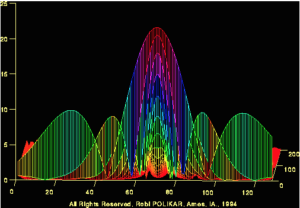If you are learning about wavelets for the first time, or if you need a good refresher, this is the site to visit first. After all, it is the engineer’s ultimate guide to wavelet analysis, and it’s #1 on Google.

Hands on engineering clinics are a hallmark of Rowan University, where Dr. Robi Polikar, Professor and Chair of Electrical and Computer Engineering, leads his Signal Processing and Pattern Recognition Laboratory, and manages his site.
With billions of sites on the world wide web, it’s good to Google. Google is pretty much set up to deliver the People’s Choice, a hopeful democratization of knowledge to present what people vote for by clicking their way along. It seems to work pretty well for math and science, especially when you can focus your search down to specific topics.
Wavelets is one such topic. Wavelets have been cool for a while, but what good are they? They are a great tool when you want to analyze something brainy – like an EEG record – and get both the frequency and the time, in other words, you get more bang for your research buck than the plain ole Fourier transform.
This site is #1 devolving from the search terms “wavelet tutorial.” The creator of the site, Robi Polikar, PhD is an electrical engineering professor at Rowan University in New Jersey, USA. He is also a pedagogical genius.
If you are learning about wavelets for the first time, or if you need a good refresher, this is the site to visit first. After all, it’s #1 on Google.
Dr. Robi Polikar is very accessible, and his site is resource rich if you are interested in his research areas such as pattern recognition, computational intelligence, learning in nonstationary environments, ensemble systems in machine learning, neural networks, early diagnosis of Alzheimer’s Disease, etc.
“I knew I had to put it into simple words to make it understandable to people.
That’s how this wavelet tutorial was first created.”
“One thing I suffered while I was learning the basics of the wavelet transform is the fact that the majority of the articles and books (if not all of them) are written by math people, for the math people, in a language which even most of the math people themselves cannot understand what is going on. I remember that I got frustrated with all those equations, trying to figure out how and where to use them. I was so frustrated at that time that I decided to write my own book some day.
When I received so many mails about the wavelet transform, I thought that writing a tutorial could be a starting point for my future dream of writing my own book of wavelet transforms.
I knew that I had to put it in simple words to make it understandable to those people. This is how this tutorial was first created.”
~ Robi Polikar, PhD

Preface
Part 1 – Overview: Why wavelet Transform?
Part 2 – Fundamentals: The Fourier transform and the short term Fourier transform, resolution problems
Part 3 – Multiresolition Analysis: The continuous wavelet transform
Part 4 – Multiresolition Analysis: The discrete Wavelet Transform
http://users.rowan.edu/~polikar/WTtutorial.html
*Updated and adapted from an original article by Dr. Henri Montandon for the Society for MindBrain Sciences.
